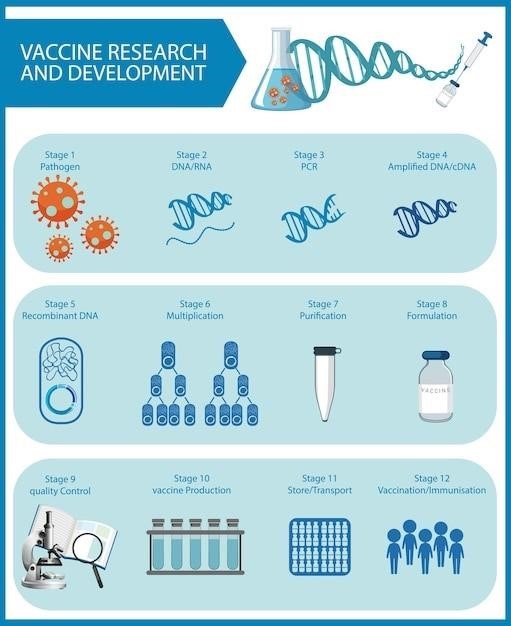DNA Replication⁚ A Comprehensive Overview
DNA replication is a fundamental biological process ensuring accurate duplication of genetic material before cell division․ This precise copying mechanism involves unwinding the double helix, separating strands, and synthesizing new complementary strands using enzymes like DNA polymerase․ The result is two identical DNA molecules, each preserving the original genetic information․ Worksheets often test comprehension of these steps․
Understanding the Basics of DNA Replication
DNA replication is the biological process of producing two identical replicas of DNA from one original DNA molecule․ This process is crucial for cell growth and reproduction, ensuring that each new cell receives a complete set of genetic instructions․ The process begins with the unwinding of the DNA double helix, separating the two strands․ Each strand then serves as a template for the synthesis of a new complementary strand․ This is achieved through the precise pairing of nucleotides – adenine (A) with thymine (T), and guanine (G) with cytosine (C); Several key enzymes facilitate this process, including DNA helicase, which unwinds the DNA, and DNA polymerase, which adds new nucleotides to the growing strands․ The result is two identical DNA molecules, each consisting of one original strand and one newly synthesized strand․ This semi-conservative replication ensures genetic fidelity, minimizing errors during the copying process․ Understanding this basic mechanism is fundamental to interpreting DNA replication diagrams and solving related problems found in worksheets․
The Role of Enzymes in DNA Replication
Several crucial enzymes orchestrate the precise and efficient process of DNA replication․ DNA helicase, a vital enzyme, initiates replication by unwinding the double helix, separating the two parental DNA strands․ This creates a replication fork, providing access to the template strands․ Following helicase, single-stranded binding proteins (SSBs) prevent the separated strands from reannealing, maintaining their accessibility for the synthesis of new strands․ RNA primase then synthesizes short RNA primers, providing a starting point for DNA polymerase․ DNA polymerase is the workhorse enzyme, adding nucleotides to the 3′ end of the RNA primer, building a new complementary DNA strand․ Different types of DNA polymerase exist, each with specific roles in replication fidelity and repair․ Finally, DNA ligase seals the gaps between the Okazaki fragments on the lagging strand, creating a continuous new DNA molecule․ These enzymes work in a coordinated fashion to ensure accurate and complete DNA replication, a process frequently depicted and analyzed in DNA replication worksheets․
Semi-Conservative Replication⁚ The Meselson-Stahl Experiment
The Meselson-Stahl experiment provided definitive evidence for the semi-conservative nature of DNA replication․ Prior to their groundbreaking work, three models were proposed⁚ conservative, semi-conservative, and dispersive․ Meselson and Stahl elegantly designed an experiment using isotopes of nitrogen (15N and 14N) to distinguish between parental and newly synthesized DNA․ E․ coli bacteria were grown in a 15N-containing medium, labeling their DNA with the heavier isotope․ These bacteria were then transferred to a 14N medium, and DNA replication was allowed to proceed․ After one generation, the DNA showed an intermediate density, consistent with the semi-conservative model – each new DNA molecule containing one parental (15N) and one newly synthesized (14N) strand․ Subsequent generations further supported this model, refuting the conservative and dispersive hypotheses․ This pivotal experiment is often featured in educational materials and worksheets on DNA replication, illustrating the scientific method and the semi-conservative mechanism of DNA duplication․

DNA Structure⁚ The Foundation of Replication
Understanding DNA’s double helix structure—with its complementary base pairing (A-T, G-C) and hydrogen bonds—is crucial for grasping how replication accurately duplicates genetic information․ This structure directly dictates the mechanism of semi-conservative replication․
The Double Helix⁚ Understanding its Components
The DNA double helix, the iconic structure of life’s blueprint, consists of two polynucleotide chains intertwined around a central axis․ Each chain, or strand, is composed of nucleotides, the fundamental building blocks of DNA․ A nucleotide comprises three components⁚ a deoxyribose sugar molecule, a phosphate group, and one of four nitrogenous bases – adenine (A), guanine (G), cytosine (C), and thymine (T)․ The sugar and phosphate groups form the backbone of the DNA strand, while the bases project inwards towards the helix’s center․ The arrangement of these bases along the strand determines the genetic code․ The two strands are held together by hydrogen bonds formed between complementary base pairs⁚ adenine pairs with thymine (A-T), and guanine pairs with cytosine (G-C)․ This specific base pairing is crucial for DNA replication, as it dictates how each strand can serve as a template for the synthesis of a new complementary strand․ The double helix structure also allows for compact packaging of the enormous length of DNA within a cell’s nucleus․ Understanding these components is fundamental to comprehending the mechanisms of DNA replication and the transmission of genetic information․ The antiparallel nature of the two strands, with one running 5′ to 3′ and the other 3′ to 5′, is another key structural feature that influences replication processes․ This intricate structure ensures the stability and accurate replication of the genetic information encoded within DNA․
Base Pairing⁚ A-T and G-C
The specificity of base pairing in DNA, where adenine (A) always pairs with thymine (T), and guanine (G) always pairs with cytosine (C), is a cornerstone of molecular biology․ This complementary pairing is dictated by hydrogen bonding⁚ A and T form two hydrogen bonds, while G and C form three, resulting in a stronger bond between G and C․ This precise pairing is crucial for several reasons․ Firstly, it ensures the accurate replication of DNA․ During replication, the two strands of the DNA double helix separate, and each strand serves as a template for the synthesis of a new complementary strand․ The base pairing rules guarantee that the newly synthesized strands are identical to the original strands․ Secondly, base pairing is essential for maintaining the structural integrity of the DNA double helix․ The hydrogen bonds between complementary base pairs hold the two strands together, creating the stable double helical structure․ Any deviation from the A-T and G-C pairing would disrupt this structure and compromise the stability of the DNA molecule․ Finally, the specific base sequence, determined by the arrangement of A, T, G, and C, encodes the genetic information that directs cellular processes and determines an organism’s traits․ Understanding the intricacies of base pairing is thus paramount for comprehending DNA’s structure, function, and replication․
The Importance of Hydrogen Bonds in DNA Structure
Hydrogen bonds play a pivotal role in establishing and maintaining the iconic double helix structure of DNA․ These relatively weak bonds, formed between complementary base pairs (A-T and G-C), are crucial for several reasons; First, they allow for the two DNA strands to be held together in a stable yet separable manner․ The strength of the hydrogen bonds is sufficient to maintain the double helix under normal physiological conditions, yet weak enough to allow for strand separation during processes such as DNA replication and transcription․ This controlled separation is essential for these critical cellular functions․ Second, the specific number of hydrogen bonds between each base pair—two for A-T and three for G-C—contributes to the overall stability of the DNA double helix․ The slightly stronger G-C bond adds to the structural integrity, impacting regions of DNA requiring greater stability․ Third, the precise arrangement of hydrogen bonds facilitates the accurate pairing of bases during DNA replication and repair․ The specific geometry of hydrogen bonding ensures that only the correct complementary base can pair with each base on the template strand, minimizing errors during these vital processes․ In essence, the hydrogen bonds are not merely a structural component but a functional element vital for DNA’s dynamic role in cellular processes․

Worksheet Answers and Practice Problems
This section provides answers and practice problems to reinforce understanding of DNA structure and replication․ Diagrams and questions test knowledge of key concepts and processes․ Solutions offer clarification and aid in mastering the subject matter․
Analyzing DNA Replication Diagrams
Analyzing DNA replication diagrams is crucial for understanding the process․ These diagrams visually represent the complex steps involved, from the unwinding of the double helix by helicase to the action of DNA polymerase in synthesizing new strands․ Careful observation helps identify key features such as the replication fork, leading and lagging strands, Okazaki fragments, and the role of RNA primers․ By tracing the movement of enzymes and nucleotides, students can visualize the semi-conservative nature of replication, where each new DNA molecule contains one original and one newly synthesized strand․ Practice interpreting these diagrams strengthens comprehension of the molecular mechanisms underlying DNA replication․ Understanding the visual representations allows for better problem-solving and application of knowledge to real-world scenarios․ Worksheets often include diagrams that require labeling of enzymes, strands, and replication processes․ Accurate interpretation of these visuals is vital for answering related questions and for a deeper understanding of the subject matter․
Interpreting Results and Solving Problems
Successfully interpreting results and solving problems related to DNA replication requires a solid grasp of the underlying principles․ This involves understanding the roles of key enzymes, the base pairing rules (A with T, G with C), and the semi-conservative nature of the replication process․ Practice problems often present scenarios such as determining the sequence of a newly synthesized strand given the template strand, or identifying errors in a replication diagram․ Analyzing experimental data, such as those from the Meselson-Stahl experiment, helps solidify understanding of semi-conservative replication․ Problem-solving might involve interpreting the results of a hypothetical experiment where different isotopes of nitrogen are used to track DNA replication․ Successfully solving these problems demonstrates a comprehensive understanding of the process and the ability to apply this knowledge to various contexts․ Key skills include identifying patterns, analyzing data, and applying the principles of DNA replication to solve practical problems․ The ability to interpret results and solve problems is crucial for assessing mastery of the topic․
